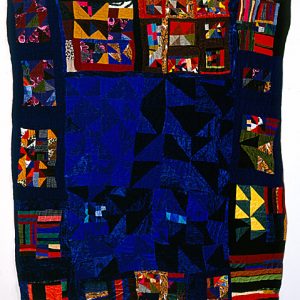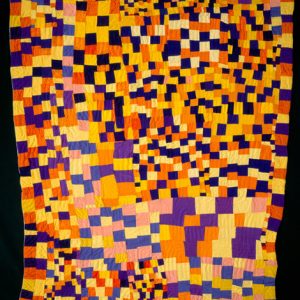calsfoundation@cals.org
Rosie Lee Tompkins (1936–2006)
aka: Effie Mae Martin Howard
Rosie Lee Tompkins was the assumed name of Effie Mae Howard, a widely acclaimed African American quiltmaker whose prodigious talents catapulted her to the forefront of contemporary art. As New York Times critic Roberta Smith put it, “Tompkins’s textile art [works]…demolish the category.”
Effie Mae Martin (Effie Mae Howard was her married name) was born in Arkansas on September 6, 1936, to Sadie Bell and MacCurey Martin. The oldest of fifteen half-siblings, she grew up picking cotton and helping her mother piece quilts in rural Gould (Lincoln County), where poverty forced the family to use every available scrap of cloth. Howard never completed high school. She moved to Richmond, California, in 1958 and took courses in nursing at various local institutions, eventually working as a practical nurse in convalescent homes—a job she loved. Naturally friendly and outgoing, she married twice and raised five children and stepchildren. For this middle part of her life, she did little or no patchwork.
By the late 1970s, however, her deepest craving was for peace of mind, for which she found patchwork helpful. A decade or so later, however, she was dismayed when her work was about to be exhibited. After some consideration, she adopted the pseudonym Rosie Lee Tompkins to stay out of the public eye. Once her work was shown, everyone wanted to know who she was.
Deeply religious, she felt that she was the instrument of God, who designed her patchworks. “I wonder how I did that!” she once exclaimed in astonishment at her own work. “It was the Lord that helped me.” In her later years, she covered her walls with patchwork appliquéd with sacred crosses to fend off intruders, and she continued to find solace in her special blend of prayer and needlework while further developing ways to infuse her patchworks with spirituality. In addition to appliquéd crosses, embroidered citations from the Bible enlivened her later work, which included book holders, curtains, table and chair covers, clothing, purses, pillows, and wall hangings. Howard pieced with particular family members in mind. Her Three Sixes quilt, in which the units of design contain approximately six variable-sized rectangles per strip, honor three of her relatives whose birth dates include the number six.
Howard’s affinity for changeable design, vibrant color, bold contrast, multiple patterns, non-four-sided borders, and radical shifts in scale and color scheme can be found in the work of African-American patchworkers nationwide, suggesting a profound influence of African art upon her work. Her unlimited elaborations on familiar patterns, for example, show an aesthetic of variation reminiscent of the raffia embroideries of the Bakuba of central Africa and of certain royal Kente cloths of the Asante of Ghana and the Ivory Coast. In Half-squares Medallion, an alluring field of blues is surrounded by a gallery of complementary colors drawing on three families of pattern. “These quilts are works of such distinction and devotion,” Artweek critic Alison Bing wrote that, “they supersede established art-historical categories, forcing reviewers to retreat to that dumfounded admiration that attracted us to art in the first place.” A vast number of quilters report having been influenced by her work, and her quilts have been purchased by the Whitney and Oakland museums.
Howard was found dead at her home on December 1, 2006. She is buried in Arkansas. Her work was the subject of a 2020 retrospective at the Berkeley Art Museum, which received coverage in the New York Times.
For additional information:
Fox, Margalit. “Rosie Lee Tompkins, African-American Quiltmaker, Dies at 70.” New York Times. December 6, 2006. Online at http://www.nytimes.com/2006/12/06/obituaries/06tompkins.html?fta=y (accessed April 11, 2022).
Leon, Eli. Accidentally on Purpose: The Management of Irregularities in African Textiles and African-American Quilts. Davenport, IA: Figge Art Museum, 2006.
———. Something Else to See: Improvisational Bordering Styles in African-American Quilts. Amherst: University of Massachusetts Press, 1997.
———. Something Pertaining to God: The Patchwork Art of Rosie Lee Tompkins. Shelburne, VT: Shelburne Museum, 2007.
———. Who’d a Thought It: Improvisation in African-American Quiltmaking. San Francisco: San Francisco Craft and Folk Art Museum, 1988.
Rinder, Lawrence, ed. “Rosie Lee Tompkins.” Berkeley, CA: Berkeley Art Museum, 1997.
Smith, Roberta. “The Radical Quilting of Rosie Lee Tompkins.” New York Times, June 29, 2020. https://www.nytimes.com/interactive/2020/06/26/arts/design/rosie-lee-tompkins-quilts.html (accessed April 11, 2022).
Eli Leon
Oakland, California
 Arts, Culture, and Entertainment
Arts, Culture, and Entertainment Blue Medallion by Rosie Lee Tompkins
Blue Medallion by Rosie Lee Tompkins  Three Sixes by Rosie Lee Tompkins
Three Sixes by Rosie Lee Tompkins 



Comments
No comments on this entry yet.